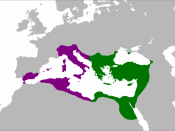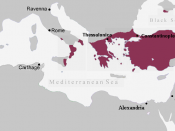Change Over Time - The changes and continuities in political, economic, and social systems from the fall of the Western Roman Empire in 476 AD to 1450 in Europe.
The Roman Empire's imperial bureaucracy, economy, and governing instructions were left to Byzantium at the end of it's reign. Although Europe didn't have very extensive unity or political order, the Byzantine policies brought Europe to a state of economical and political order, with a big area for trade and interaction, and cultural unity.
Only Byzantium survived the declining population, outside military threats, economic contradiction, epidemic disease, and political trouble after the fall of Rome. The rulers of the Byzantine empires were sporadically increasing their borders, and The Constantine came to be ruler, he had a big part in supporting Christianity and ecclesiastical affairs. And once rule switched over to Justinian, he influenced the codification or Roman Law, and because of his code, most of Europe's laws were influenced by Roman law.
The Slavic peoples also benefited from being able to shift over into the Byzantine Empire when the Byzantine military resources were sent over to the Western Mediterranean by Justinian. Before the 8th century Bulgaria and Byzantine had taken part in cultural, political, and commercial affairs.
Starting around the 5th century and leading up to the 12th, economical prosperity and political stability was brought to Eastern Europe by the Byzantine empire. Cultural and commercial exchanges were also supported in the post-classical world, which would help shape the development of the commonwealth in Eastern Europe.
The political leaders also set up a sequence of independent states while enduring economical and political reform in western Europe, and supported their society. So, generally speaking, all of the different societies that were established under Byzantium's economic, political, and cultural influences from 476 to 1450 still...



It was Okay
You used alot of details but to a person like me it made no sence....it might be good I dont know ill give you a :| for your efforts
4 out of 6 people found this comment useful.